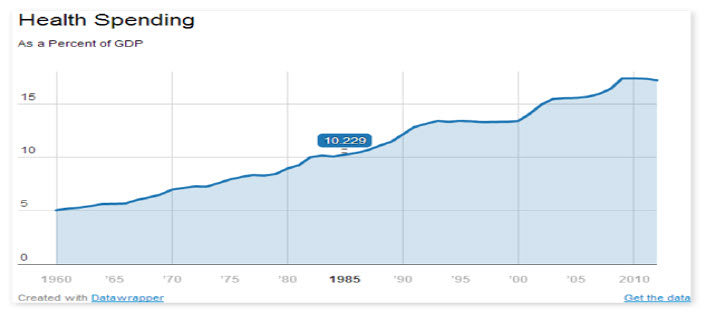The evolution of health care spending has important implications for many aspects of our economy. As highlighted by this conference, the trajectory of health spending growth is a central determinant of the outlook for federal and state budgets and for workers’ take-home pay. Health spending also affects other key economic variables, including measured productivity and prices. Further, the coming demographic change has important implications for both the level and financing of health spending. For these reasons, the question of what drives health spending growth is a subject that has received much attention from researchers and policymakers, although, as I hope to show in this background paper, much remains to be learned.
The basic questions driving all this attention are simple: Why has the share of health spending in GDP been rising for decades? And when and how will this trend stop? Recently, there has been much debate about the slowdown in health spending growth observed over the past few years. Analysts have been trying to determine whether this slowdown is simply the result of the recent recession, or whether it reflects something new.1 In this paper, I first step back from the question of the recent slowdown and attempt to provide some background on the key determinants of health spending growth and how these have evolved over time. I then address the recent slowdown.
Accounting for Health Cost Growth
As shown in Figure 1, the share of health spending in GDP has increased sharply over time, from 5 percent of GDP in 1960 to over 17 percent today. Many researchers have attempted to link the rapid rise in health spending over time to such factors as income growth, the relative price of health care, demographics, and changes in insurance coverage. The earliest work (Newhouse (1992, 1993)), using household-level estimates of the responsiveness of the demand for health care to income and prices, found that these factors could explain very little of the rise in health spending, and concluded that technology—the residual—must be responsible for most of the growth.

However, more recent work (including Smith, Newhouse, and Freeland (2009) and Follette and Sheiner (2005)) recognized that household-level estimates may not be appropriate for predicting the macroeconomic impact of changes in income or insurance coverage. Cross-country and time-series estimates of the income elasticity, for example, suggest much larger estimates than can be found by comparing health consumption by households of different incomes at a single point in time (Getzen( 2000.)) Similarly, Amy Finkelstein’s work (Finkelstein, 2005) showed that the introduction of Medicare had much larger effects on spending than would be estimated using the household-level estimates of the effects of price elasticities derived from the Rank Health Insurance Experiment.
![]()
The evolution of health care spending has important implications for many aspects of our economy. The trajectory of health spending growth is a central determinant of the outlook for federal and state budgets and for workers’ take-home pay. Health spending also affects other key economic variables, including measured productivity and prices. Further, the coming demographic change has important implications for both the level and financing of health spending. For these reasons, the question of what drives health spending growth is a subject that has received much attention from researchers and policymakers, although, as shown in this background paper, much remains to be learned.
The basic questions driving all this attention are simple: Why has the share of health spending in GDP been rising for decades? And when and how will this trend stop? Recently, there has been much debate about the slowdown in health spending growth observed over the past few years. Analysts have been trying to determine whether this slowdown is simply the result of the recent recession, or whether it reflects something new. In this paper, Sheiner first steps back from the question of the recent slowdown and attempts to provide some background on the key determinants of health spending growth, and how these have evolved over time. Sheiner then addresses the recent slowdown.
